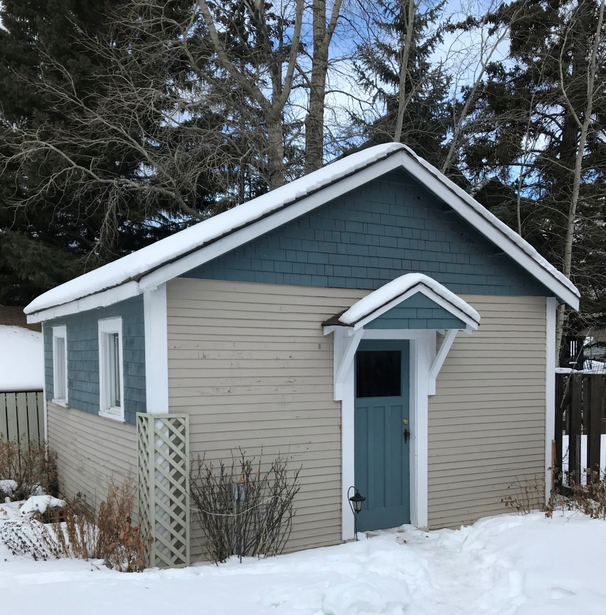BANFF – Two more bed and breakfast operations have been approved in Banff as town council gets set to tighten regulations for visitor accommodation within residential neighbourhoods.
On Wednesday (April 12), the Municipal Planning Commission approved a B&B accommodation at a home at 218 St.-Julien Rd., a 1940 heritage home known as the Wakleyn residence, and another in a historic 1931 backyard cabin at 345 Otter St.
Parks Canada took issue with the conversion of the cabin into a B&B amid concerns for loss of housing and that it may be against the park management plan, while Commissioner Barb Pelham questioned the potential loss of residential housing at the St-Julien Road property.
“I am looking at the current floor plan and it appears it functions as a two-bedroom suite at this point,” said Pelham, a council representative on the commission.
“I just want to confirm we’re basically losing two bedrooms of accommodation for residents for a one-unit B&B, so that’s the tradeoff that appears to be happening.”
The homeowners are renovating the basement to make way for one commercial accommodation unit only at their St.-Julien Road property in a neighbourhood where there are five of 10 B&B allocations remaining under the district cap.
Michelle Lemieux, the live-in owner, said the space is currently only rented as a one-bedroom for couples even though there are two bedrooms.
“It’s not like a two-bedroom apartment; we rent it out as a one-bedroom,” she said.
Commissioner Stavros Karlos, chair of MPC, said residential housing is a concern for everyone.
“But that’s within the purview of town council to decide what that policy looks like in the future,” he said.
Bed and breakfast homes are a discretionary use in all land use districts in which they are allowed.
Banff has a quota of 65 bed and breakfast homes and inns town-wide, with allocations split amongst various districts. Currently, 47 permits have been allocated for B&B inns, which are more like boutique hotels, and B&B homes combined
However, a long-awaited draft bylaw aimed at strengthening B&B regulations is before the governance and finance committee on Monday, April 24, with a key proposal to move away from a district allocation to only a town-wide cap.
The bylaw proposes a town-wide limit of 42 B&B homes, but there would be an allowance for an additional 15 provided they are legally protected municipal historic resources.
The change does not alter the overall cap on B&B homes and inns, but changes how these might be distributed and allocated. With the move away from district quotas, there is also a proposal to prevent B&B homes from opening on adjacent lands or within three parcels on the same street.
“We’ve always seen a lot of interest in some of the districts that have been at maximum capacity for a number of years, and when an allocation becomes available they get snapped up pretty quickly,” said Dave Michaels, the manager of development services for the Town of Banff.
“Then we have other districts that have a larger allocation that have sat relatively low.”
The Municipal Planning Commission also gave the go-ahead for one commercial accommodation unit within an accessory structure – a one-storey cabin – to a single detached home at the rear of the property at 345 Otter St.
The condition of the building, known as Hoggard Cabin, has deteriorated over time and the applicant is proposing to renovate and rehabilitate the heritage resource for the purpose of a B&B room. The cabin is listed on the Town of Banff’s municipal heritage inventory.
In a district where there is a cap of nine B&Bs, there are currently six in operation.
“Therefore, there is available capacity in this district to accommodate this application,” said Kathleen Gallagher, development planner for the Town of Banff.
Parks Canada raised concerns the proposal may not align with the direction in the 2022 Banff National Park Management Plan to maximize available space in residential land use districts for use as housing by eligible residents.
The agency notes although the land use bylaw currently permits nine B&Bs within the district, approval of this application would signal a shift away from prioritizing existing available housing for eligible residents by re-purposing a detached residential structure for exclusive use as a B&B.
“The proposed bed and breakfast home will not contain a residential bedroom within it,” the agency wrote in its feedback to the Town of Banff on this proposal.
“Prior to the issuance of a development permit, Parks Canada requires clarification from the Town of Banff describing how the proposal conforms to the direction in the Banff National Park Management Plan 2022.”
In response, Michaels said it is the Town of Banff’s interpretation the B&B unit does comply with the management plan, noting the current direction in the management plan is for a quota system for B&B homes, which currently exists.
He also said there is evidence the cabin was used as visitor accommodation prior to the municipality’s incorporation.
“Ultimately, it’s up to MPC to decide whether the application is consistent with the management plan,” said Michaels.
“You can’t approve an application that isn’t. It’s our interpretation is that it is. Parks Canada highlighted that it may not and they highlighted why.”
Commissioner Karlos indicated he believed the application fits within the management plan rules.
“We currently have a system in place as we’ve discussed for a maximum number of B&Bs established by municipal government,” he said.




